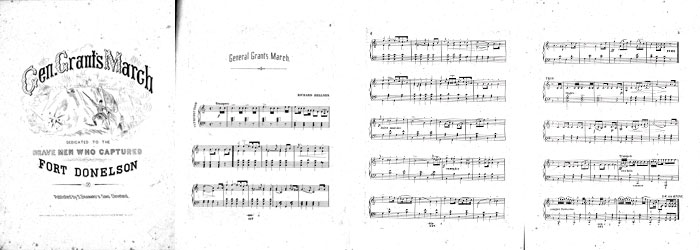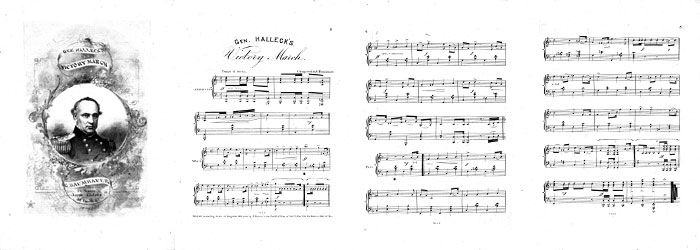
Sheet music - Gen. Grantís March, (Cleveland, OH: S. Barnardís Sons, 1862).
Dedicated to the Brave Men who Captured Fort Donelson.
SAHRL Lillian Stegner collection, preserved in State Historical Society of North Dakota, Bismarck, ND.
The Union army was campaigning to win control of the Mississippi Valley. Union forces under the command of Ulysses S. Grant battled for Fort Donelson, on the Cumberland River from February 12 to 16, 1862. When the Confederate commander asked for terms, Grant replied, “No terms except an unconditional and immediate surrender can be accepted.” Brigadier General Simon Bolivar Buckner capitulated and Ulysses S. Grant acquired the nickname, “Unconditional Surrender” Grant. An invasion route to the South was open, and President Lincoln promoted Grant to major general of volunteers.

Sheet Music - B. Baumhauer, Gen. Halleckís Victory March, (St. Louis, MO: Jacob Endres, 1862).
SAHRL Lillian Stegner collection, preserved in State Historical Society of North Dakota, Bismarck, ND.
Major General Henry W. Halleck succeeded Ulysses S. Grant as commander of the 9th Illinois Volunteer Infantry. This march was written to celebrate the Union victory at the 1st Battle of Corinth (Siege of Corinth), May 10 to 30, 1862. This battle followed the battles at Fort Henry, Fort Donelson, and Shiloh. Corinth, Mississippi, was a vital rail center for the Mobile and Ohio Railroad.
1. Listen to web-cam recordings of Gen. Grant’s March and Gen. Halleck’s Victory March.
2. Essay assignment: How is this music similar or dissimilar to today’s style of music?
1) tempo
2) instrumentation
3) theme
4) printing techniques / notation
3. Print out the music of Gen. Grant’s March or Gen. Halleck’s Victory March.
4. Learn to play the march.
5. Play the march for your music teacher.



